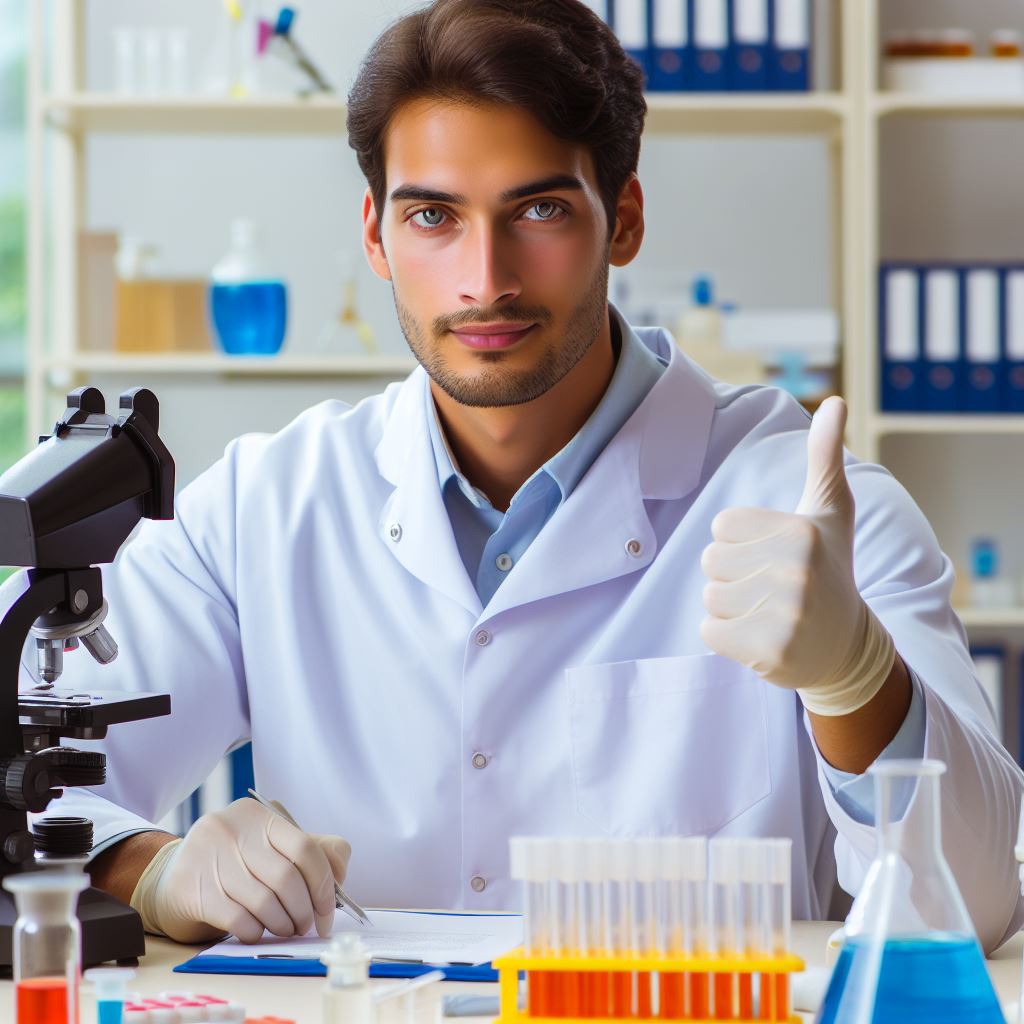Introduction
Lab safety is a paramount concern in any scientific or research setting.
It encompasses various practices and precautions that aim to protect researchers, prevent accidents, and maintain a safe working environment.
Following safety guidelines diligently is of utmost importance to minimize risks and ensure the well-being of all individuals involved.
In this blog post, we will delve into the realm of lab safety and provide valuable insights and recommendations from experts in New Zealand.
These experts have extensive knowledge and experience in practicing safe protocols within laboratories, enhancing the credibility of their advice.
The tips and insights shared by these NZ experts will cover a range of fundamental aspects of lab safety.
From handling hazardous substances and using equipment properly, to implementing emergency procedures, the wisdom imparted by these professionals will be invaluable for both novice and experienced researchers alike.
By exploring this comprehensive guide to lab safety, you will gain a deeper understanding of the importance of adhering to safety guidelines.
Whether you are a student about to embark on a journey of scientific discovery or a seasoned researcher seeking to reinforce your safety practices, these insights will serve as a vital resource to protect yourself and your colleagues from potential hazards.
So, without further ado, let’s dive into the world of lab safety and uncover the tips and insights that NZ experts have to offer.
Stay safe and make your scientific endeavors a secure and productive experience.
Importance of Lab Safety
Potential hazards in a laboratory setting
- Laboratories are filled with potentially dangerous substances and equipment.
- Chemicals, fire, explosions, and electrical hazards are common risks in a lab.
- Lack of precautionary measures can lead to serious accidents or even fatalities.
- Failure to properly handle and store chemicals can result in toxic fumes or chemical reactions.
- Mishandling of equipment or not wearing appropriate protective gear can cause physical harm.
Risks associated with disregarding safety protocols
- Ignoring safety protocols increases the chances of accidents and injuries.
- Disregarding safety guidelines can lead to chemical spills or exposure to harmful substances.
- Inadequate ventilation or improper disposal of waste can harm both individuals and the environment.
- Non-compliance with proper equipment usage can lead to electrical shocks or fires.
- Failure to follow safety protocols can threaten the well-being of all individuals working in the laboratory.
Role of lab safety in preventing accidents and injuries
- Lab safety procedures are designed to mitigate potential risks and create a safe working environment.
- Following safety protocols ensures the protection of individuals and their colleagues.
- Proper use of personal protective equipment minimizes the chance of injury or exposure to hazardous substances.
- Regular safety training and awareness programs help employees understand and respond to potential dangers.
- Adhering to lab safety protocols demonstrates a commitment to a culture of safety and responsibility.
In essence, lab safety is of utmost importance due to the potential hazards present in a laboratory setting.
Emphasizing these hazards and discussing the risks associated with disregarding safety protocols helps raise awareness among individuals working in laboratories.
Lab safety plays a crucial role in preventing accidents and injuries by implementing precautionary measures, such as proper handling and storage of chemicals, wearing protective gear, and following safety procedures.
By prioritizing lab safety, individuals can maintain a safe working environment and protect themselves and their colleagues from potential harm.
Personalized Career Consulting
Unlock your potential with expert career advice tailored to your goals. Get personalized guidance and actionable steps toward your dream career in New Zealand.
Get StartedRead: Emerging Trends in NZ Lab Research
Key Lab Safety Rules
Essential lab safety rules
- Proper use and handling of chemicals.
- Adherence to personal protective equipment (PPE) requirements.
- Following equipment operation and maintenance guidelines.
- Ensuring proper waste disposal procedures.
- Knowledge and implementation of emergency protocols.
The rationale behind each rule
- Proper use and handling of chemicals: This rule is crucial to prevent accidents, chemical spills, and potential harm to oneself and others in the lab.
- Adherence to personal protective equipment (PPE) requirements: Wearing appropriate PPE safeguards against exposure to hazardous materials and reduces the risk of injuries.
- Following equipment operation and maintenance guidelines: Proper usage and maintenance of lab equipment ensure accurate results and minimize the chances of accidents or equipment malfunction.
- Ensuring proper waste disposal procedures: Correct waste disposal prevents environmental contamination and ensures the safety of lab personnel.
- Knowledge and implementation of emergency protocols: Being prepared for emergencies and knowing the necessary protocols can save lives and minimize injuries during critical situations.
Importance of adherence to these rules
Adherence to lab safety rules is of paramount importance for the well-being of both individuals and the entire lab community.
The rules protect researchers and staff from accidents, injuries, exposure to harmful substances, and potentially life-threatening situations.
Proper use and handling of chemicals is necessary to safeguard against accidental spills, reactions, and exposure to toxic substances.
It minimizes the risk of chemical reactions that can lead to fires, explosions, or the release of hazardous gases.
Adhering to guidelines on personal protective equipment (PPE) is crucial as it forms the first line of defense against potential hazards.
Wearing safety goggles, lab coats, gloves, and respiratory masks when required, shields individuals from splashes, spills, burns, or inhaling harmful fumes.
Equipment operation and maintenance guidelines should be followed meticulously to avoid equipment malfunction, breakdowns, or accidents.
Regular maintenance, calibration, and proper use of lab instruments contribute to accurate results and reliable data, crucial for scientific research.
Additionally, adhering to proper waste disposal procedures ensures the containment and proper handling of hazardous materials, preventing environmental contamination and the spread of diseases.
Knowledge and implementation of emergency protocols are vital in mitigating risks during critical situations.
Familiarity with safety exits, emergency equipment, and evacuation plans can save lives and limit injuries.
In case of fire, chemical spills, or other emergencies, prompt and appropriate response is crucial to prevent further harm and ensure the safety of all individuals in the lab.
By strictly adhering to lab safety rules, individuals create a culture of safety, fostering a secure and productive working environment.
Transform Your Career with a Professional CV and Cover Letter
Stand out to employers with an ATS-optimized resume and tailored cover letter designed to match your dream role. Let us craft your job application materials for success!
Get StartedIt is essential for all lab members to be vigilant, responsible, and accountable for their actions.
Adherence to safety rules should be consistently reinforced through regular training, reminders, and strict enforcement of protocols.
Read: NZ Lab Techs: Required Qualifications

Safety Equipment and Facilities
The Significance of Safety Equipment in a Lab
- The presence of safety equipment is crucial for maintaining a safe laboratory environment.
- Safety equipment helps to identify and minimize potential hazards that can lead to accidents.
- It provides protection to lab personnel and helps prevent injuries and damages.
- Without proper safety equipment, lab workers are exposed to risks and the lab becomes vulnerable to accidents.
Overview of Essential Safety Equipment
Fire extinguishers and fire safety equipment
- Fire extinguishers are essential in case of any fire emergencies within the lab.
- They need to be easily accessible, properly maintained, and employees should be trained to use them.
Eye wash stations and safety showers
- In case of chemicals splashing into the eyes or on the body, immediate flushing is crucial.
- Eye wash stations and safety showers provide a quick and effective way to rinse off chemicals.
Fume hoods and ventilation systems
- Fume hoods help in removing hazardous fumes, vapors, and gases from the laboratory.
- Proper ventilation systems prevent the build-up of toxic substances and ensure air circulation.
First aid kits and emergency medical equipment
- First aid kits contain essential supplies to treat minor injuries and provide immediate care.
- Emergency medical equipment, such as AEDs, should be readily available for any medical emergencies.
Safety cabinets for storing chemicals
- Proper storage of chemicals in safety cabinets reduces the risk of accidents and chemical spills.
- Cabinets should be labeled correctly and organized to facilitate easy access and prevent cross-contamination.
The Need for Proper Maintenance and Inspection of Safety Equipment
- Regular maintenance and inspection of safety equipment are essential to ensure their functionality.
- Periodic checks should be performed to make sure equipment is in good working condition.
- Any malfunctioning or damaged equipment should be repaired or replaced promptly.
- Lab personnel should be trained in the proper usage and maintenance of the safety equipment.
- Emergency response plans should also be regularly reviewed and updated.
Proper safety equipment utilization, along with regular maintenance and inspection, is key to creating a safe and secure laboratory environment for all individuals.
Read: Salary Guide for NZ Lab Technicians
Training and Education
Importance of Receiving Proper Lab Safety Training
Receiving proper lab safety training is crucial for safeguarding individuals and promoting a secure working environment.
Role of Educational Institutions and Employers in Providing Training Programs
Educational institutions and employers play a vital role in ensuring comprehensive lab safety training programs.
They should integrate safety guidelines into their curriculum, providing students with a solid foundation.
Employers must prioritize training to guarantee the well-being of their employees.
Benefits of Continuous Education and Learning about Lab Safety
Continuous education and learning about lab safety offer several advantages to individuals and organizations alike.
- It allows individuals to stay updated with the latest safety protocols and advancements in technology.
- Enhanced knowledge enhances competence and reduces the likelihood of accidents or mishaps.
- For organizations, a well-trained workforce fosters a culture of safety and instills confidence in clients.
Availability of Online Resources and Courses for Further Education
To facilitate ongoing education and convenience, numerous online resources and courses are available for lab safety.
- Online platforms provide flexibility by enabling self-paced learning, catering to individual preferences and schedules.
- These resources offer interactive modules, videos, quizzes, and virtual simulations to enhance learning effectiveness.
- Additionally, online communities and forums allow individuals to connect, share experiences, and seek advice from experts.
By harnessing these resources, individuals can augment their knowledge and continually improve lab safety practices.
Read: Lab Tech Careers in NZ’s Top Institutes
Case Studies and Expert Tips
Real-life anecdotes or case studies demonstrating the consequences of ignoring lab safety
In 2015, a lab technician in Auckland suffered severe burns when a chemical exploded due to improper handling.
Boost Your Career with a Standout LinkedIn Profile
Attract recruiters and expand your network with a fully optimized LinkedIn profile tailored to highlight your strengths and professional goals. Let your profile open doors to new opportunities!
Get OptimizedA student in Wellington accidentally spilled a corrosive substance on their skin, resulting in a painful chemical burn.
Ignoring safety protocols, a researcher in Christchurch caused a fire in the lab, leading to significant damage and potential harm to others.
A laboratory in Hamilton had to be evacuated after a chemical reaction went wrong, releasing toxic fumes that endangered everyone inside.
Expert tips and insights from NZ professionals in the field
1. Handling hazardous substances safely
Always wear appropriate personal protective equipment (PPE), such as gloves, goggles, and lab coats when handling hazardous substances.
Ensure proper ventilation in the lab to prevent exposure to harmful vapors or fumes.
Follow the correct procedures for handling, storing, and disposing of hazardous substances as recommended by experts.
2. Preventing accidents during experiments or procedures
Read and understand the experiment protocol thoroughly before starting any procedures.
Always work in a clean and organized environment to minimize the risk of accidents.
Pay attention to details and be cautious when using sharp objects or heat sources during experiments.
Never work alone in the lab and always inform colleagues or supervisors about your activities.
3. Ensuring proper storage and labeling of chemicals
Store chemicals in designated areas, away from incompatible substances and heat sources.
Keep chemicals properly labeled with complete information about their content and hazards.
Regularly inspect chemical storage areas to ensure containers are tightly sealed and in good condition.
4. Creating a culture of safety in the lab environment
Provide comprehensive lab safety training to all personnel, including students, researchers, and staff.
Encourage open communication about safety concerns or near misses to promote a proactive approach to safety.
Implement regular safety audits and inspections to identify and address potential hazards promptly.
Establish an effective emergency response plan and ensure everyone is familiar with proper procedures during emergencies.
Overall, it is crucial for everyone working in a laboratory environment to prioritize safety at all times.
Ignoring lab safety measures can lead to severe consequences, ranging from personal injuries to property damage, and even endangering lives.
By learning from real-life case studies and following expert tips, we can create a safer lab environment in New Zealand.
Conclusion
Achieving and maintaining lab safety is of utmost importance for all individuals involved in or around laboratories.
In this blog post, we have highlighted key tips from NZ experts to ensure a safer lab experience.
To summarize, it is crucial to adhere to proper lab safety protocols, such as wearing appropriate protective gear, handling hazardous materials with caution, and maintaining a clean and organized workspace.
Additionally, regular inspection and maintenance of lab equipment, as well as proper storage and disposal of chemicals, are vital to prevent accidents and minimize risks.
We cannot emphasize enough the significance of lab safety. It not only safeguards the well-being of individuals but also protects the integrity of experiments and research outcomes.
We strongly encourage our readers to implement the tips and guidelines provided by NZ experts.
By doing so, you will contribute to creating a culture of safety and reduce the likelihood of accidents or incidents in the lab.
Remember, lab safety is a shared responsibility. Let’s prioritize it and ensure a safer environment for everyone involved in scientific endeavors.




